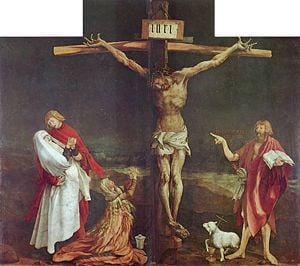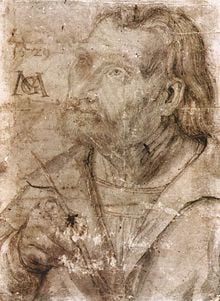Grunewald, Matthias
David Doose (talk | contribs) m (→Gallery) |
|||
| Line 5: | Line 5: | ||
==Biography== | ==Biography== | ||
| − | The details of his life are unusually unclear for a painter of his significance at this date, despite the fact that his commissions show that he had reasonable recognition in his own lifetime. His real name remains uncertain, but was definitely not Grünewald; this was a mistake by the 17th-century writer, [[Joachim von Sandrart]], who confused him with another artist. He is documented as "Master Mathis" or "Mathis the Painter" (Mathis der Maler), and as using as surname both Gothart and Neithardt - this last may have been his surname, or more likely that of his wife. He was probably born in [[Würzburg]] | + | The details of his life are unusually unclear for a painter of his significance at this date, despite the fact that his commissions show that he had reasonable recognition in his own lifetime. His real name remains uncertain, but was definitely not Grünewald; this was a mistake by the 17th-century writer, [[Joachim von Sandrart]], 150 years after his death, who confused him with another artist. He is documented as "Master Mathis" or "Mathis the Painter" (Mathis der Maler), and as using as surname both Gothart and Neithardt - this last may have been his surname, or more likely that of his wife. He was probably born in [[Würzburg]] between 1470 and 1475. It is possible he was a pupil of [[Hans Holbein the Elder]]. By 1500, he was a 'free master' and settled in the small town of Seligenstadt, where he bought a house and a pond and opened a workshop for painters and woodcarvers. |
| + | His first dated painting is probably in Munich, dated 1503 on a much later note which apparently records an older inscription. | ||
| + | From about 1510 to 1525 he served in the [[Rhineland] he became court painter to the Archbishop of Mainz and to his successor, Albrecht of Brandenburg, (whose face he used for a St Erasmus in Munich) Archbishop of Magdeburg, later bishop and Elector of Mainhz and from, 1518, Cardinal. | ||
| + | Among his other patrons were a canon in Aschaffenburg and the 'preceptor' of the Anthonite monastery at Eisenheim in Alsace. Albrecht of Brandenburg, at first showed tolerance and even sympathy for the Lutheran Reformation but soon became an implacable opponent. | ||
| − | + | He left this post possibly because of sympathies either with the [[Peasants' War]], in which Seligenstadt was particularly caught up, or [[Lutheranism]] (he had some Lutheran pamphlets and papers at his death). In 1526 he moved to Frankfurt and in the following year to [[Halle, Saxony-Anhalt|Halle]], where he died, probably in 1528, or perhaps 1531. | |
[[Image:Mathis Gothart Grünewald 022.jpg|The Crucifixion of Jesus Christ|right|300px|thumb|''The [[Crucifixion]]'', central panel of the [[Isenheim Altarpiece]].|left]] | [[Image:Mathis Gothart Grünewald 022.jpg|The Crucifixion of Jesus Christ|right|300px|thumb|''The [[Crucifixion]]'', central panel of the [[Isenheim Altarpiece]].|left]] | ||
| + | |||
==Works== | ==Works== | ||
Only religious works are included in his small surviving corpus, the most famous being the ''[[Isenheim Altarpiece]]'', completed 1515, now in the [[Musée d'Unterlinden]], [[Colmar]]. Its nine images on twelve panels contain scenes of the ''Annunciation'', ''Mary bathing Christ'', ''Crucifixion'', ''Entombment of Christ'', ''Resurrection'', ''Temptation of St. Anthony'' and saints. As was common in the preceding century, there are different views, depending on the arrangement of the wings; but the three views available here are exceptional. The third view discloses a carved and gilded wood altarpiece in the centre. As well as being by far his greatest surviving work, the altarpiece contains most of his surviving painting by area, being 2.65 metres high and over 5 metres wide at its fullest extent. | Only religious works are included in his small surviving corpus, the most famous being the ''[[Isenheim Altarpiece]]'', completed 1515, now in the [[Musée d'Unterlinden]], [[Colmar]]. Its nine images on twelve panels contain scenes of the ''Annunciation'', ''Mary bathing Christ'', ''Crucifixion'', ''Entombment of Christ'', ''Resurrection'', ''Temptation of St. Anthony'' and saints. As was common in the preceding century, there are different views, depending on the arrangement of the wings; but the three views available here are exceptional. The third view discloses a carved and gilded wood altarpiece in the centre. As well as being by far his greatest surviving work, the altarpiece contains most of his surviving painting by area, being 2.65 metres high and over 5 metres wide at its fullest extent. | ||
Revision as of 04:11, 16 January 2009
- The title of this article contains the character Ü. Where it is unavailable or not desired, the name may be represented as Matthias Gruenewald.
Matthias Grünewald or "Mathis" (as first name), "Gothart" or "Neithardt" (as surname), (c. 1470 – August 31 1528), was an important German Renaissance painter of religious works, who ignored Renaissance classicism to continue the expressive and intense style of late medieval Central European art into the 16th century. Only ten paintings (several consisting of many panels) and thirty-five drawings survive, all religious, although many others were lost at sea in the Baltic on their way to Sweden as war booty. His reputation was obscured until the late nineteenth century, and many of his paintings attributed to Albrecht Dürer, who is now seen as his stylistic antithesis. His largest and most famous work is the Isenheim Altarpiece in Colmar, Alsace (now in France).
Biography
The details of his life are unusually unclear for a painter of his significance at this date, despite the fact that his commissions show that he had reasonable recognition in his own lifetime. His real name remains uncertain, but was definitely not Grünewald; this was a mistake by the 17th-century writer, Joachim von Sandrart, 150 years after his death, who confused him with another artist. He is documented as "Master Mathis" or "Mathis the Painter" (Mathis der Maler), and as using as surname both Gothart and Neithardt - this last may have been his surname, or more likely that of his wife. He was probably born in Würzburg between 1470 and 1475. It is possible he was a pupil of Hans Holbein the Elder. By 1500, he was a 'free master' and settled in the small town of Seligenstadt, where he bought a house and a pond and opened a workshop for painters and woodcarvers. His first dated painting is probably in Munich, dated 1503 on a much later note which apparently records an older inscription. From about 1510 to 1525 he served in the [[Rhineland] he became court painter to the Archbishop of Mainz and to his successor, Albrecht of Brandenburg, (whose face he used for a St Erasmus in Munich) Archbishop of Magdeburg, later bishop and Elector of Mainhz and from, 1518, Cardinal. Among his other patrons were a canon in Aschaffenburg and the 'preceptor' of the Anthonite monastery at Eisenheim in Alsace. Albrecht of Brandenburg, at first showed tolerance and even sympathy for the Lutheran Reformation but soon became an implacable opponent.
He left this post possibly because of sympathies either with the Peasants' War, in which Seligenstadt was particularly caught up, or Lutheranism (he had some Lutheran pamphlets and papers at his death). In 1526 he moved to Frankfurt and in the following year to Halle, where he died, probably in 1528, or perhaps 1531.

Works
Only religious works are included in his small surviving corpus, the most famous being the Isenheim Altarpiece, completed 1515, now in the Musée d'Unterlinden, Colmar. Its nine images on twelve panels contain scenes of the Annunciation, Mary bathing Christ, Crucifixion, Entombment of Christ, Resurrection, Temptation of St. Anthony and saints. As was common in the preceding century, there are different views, depending on the arrangement of the wings; but the three views available here are exceptional. The third view discloses a carved and gilded wood altarpiece in the centre. As well as being by far his greatest surviving work, the altarpiece contains most of his surviving painting by area, being 2.65 metres high and over 5 metres wide at its fullest extent.
His other works are in Germany, except for a small Crucifixion in Washington and another in Basel, Switzerland. He was asked in about 1510 to paint four saints in grisaille for the outside of the wings of Dürer's Heller Altarpiece in Frankfurt. Dürer's work was destroyed by fire and only survives in copies, but fortunately the wings have survived. There are also the late Tauberbischofsheim altarpiece in Karlsruhe, and the Establishment of the Santa Maria Maggiore in Rome (1517-1519), Freiburg, Augustinermuseum. A large panel of Saint Erasmus and Saint Maurice in Munich probably dates from 1521-24, and was apparently part of a larger altarpiece project, the rest of which has not survived. Other works are in Munich, Karlsruhe, and Rhineland churches. Altogether four somber and awe-filled Crucifixions survive. The visionary character of his work, with its expressive colour and line, is in stark contrast to Albrecht Dürer's works. His paintings are known for their dramatic forms, vivid colors, and depiction of light.
Reputation
The Protestant theologian Philipp Melanchthon is one of the few contemporary writers to refer to Grünewald, who is rather puzzlingly described as "moderate" in style, when compared with Dürer and Cranach; what paintings this judgement is based on is uncertain. By the end of the century, when the Holy Roman Emperor, Rudolph II embarked on his quest to secure as many Dürer paintings as possible, the Isenheim Altarpiece was already generally believed to be a Dürer. In the late 19th century he was rediscovered, and became something of a cult figure, with the angst-laden expressionism, and absence of any direct classicism, of the Isenheim Altarpiece appealing to both German Nationalists and Modernists. Joris-Karl Huysmans promoted his art enthusiastically in both novels and journalism, rather as Proust did that of Vermeer. His apparent sympathies with the peasants in the Peasants' War also brought him admiration from the political left. Elias Canetti wrote his novel Auto-da-Fé surrounded by reproductions of the Isenheim altarpiece stuck to the wall.
The composer Paul Hindemith based his 1938 opera Mathis der Maler on the life of Grünewald during the Peasants' War; scene Six includes a partial re-enactment of some scenes from the Isenheim Altarpiece.
He is commemorated as an artist and quasi-saint by the Lutheran Church on April 6, along with Dürer and Cranach.
Gallery
- Issenheim altarpiece view 2.jpg
Isenheim Altarpiece, 1515.
See also
- Early Renaissance painting
- German Renaissance
Notes
ReferencesISBN links support NWE through referral fees
- Cuttler, Charles D. (1968) Northern Painting from Pucelle to Bruegel. Holt, Rinehart and Winston, Inc. ISBN 0-03-072500-3
External links
- Grünewald Gallery at MuseumSyndicate. Retrieved May 3, 2008.
- Grünewald paintings at CGFA. Retrieved May 3, 2008.
| Persondata | |
|---|---|
| NAME | Grünewald, Matthias |
| ALTERNATIVE NAMES | Gothart-Nithart, Mathis;Gruenewald, Matthias |
| SHORT DESCRIPTION | German Renaissance painter |
| DATE OF BIRTH | |
| PLACE OF BIRTH | |
| DATE OF DEATH | 31 August 1528 |
| PLACE OF DEATH | Halle (Saale) |
Credits
New World Encyclopedia writers and editors rewrote and completed the Wikipedia article in accordance with New World Encyclopedia standards. This article abides by terms of the Creative Commons CC-by-sa 3.0 License (CC-by-sa), which may be used and disseminated with proper attribution. Credit is due under the terms of this license that can reference both the New World Encyclopedia contributors and the selfless volunteer contributors of the Wikimedia Foundation. To cite this article click here for a list of acceptable citing formats.The history of earlier contributions by wikipedians is accessible to researchers here:
The history of this article since it was imported to New World Encyclopedia:
Note: Some restrictions may apply to use of individual images which are separately licensed.




